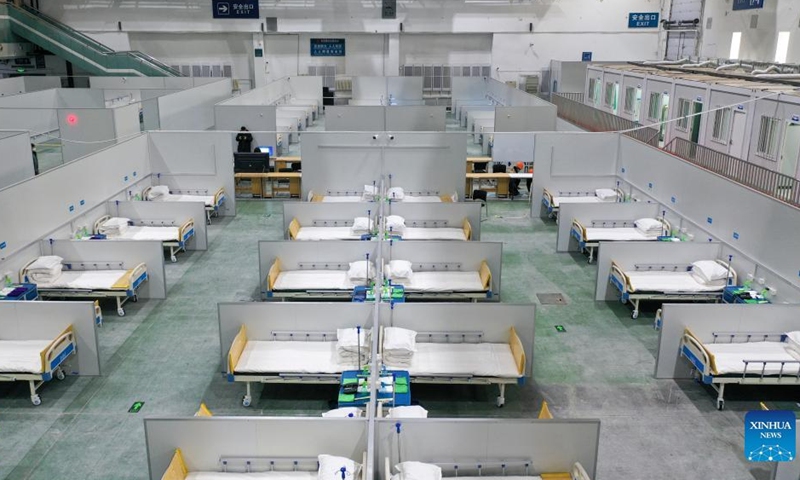
Aerial photo taken on March 15, 2022 shows the interior view of a temporary hospital for the COVID-19 patients in Changchun, capital of northeast China's Jilin Province. Jilin Province reported 3,076 new locally transmitted COVID-19 cases on Monday. Photo: Xinhua
China has updated its diagnosis and treatment playbook for COVID-19, including isolating mild cases rather than taking them to hospitals, changing the criteria for patients to be discharged from hospitals and adding antigen testing for detection.
Experts said the adjustment is a further step towards a more "scientifically relaxed" anti-epidemic policy and will greatly ease the pressure the country faces on its medical resources amid the severest rise in local COVID-19 cases in two years caused by the Omicron variant.
The National Health Commission updated the treatment playbook for COVID-19 on Tuesday based on the transmission characteristics of the virus' variants, including Delta and Omicron, as well as the high proportion of mild cases.
The revisions include optimizing case detection, reporting procedures, classification of types of treatment and further standardization of antiviral therapy.
According to the new plan, patients with mild symptoms will be put under quarantine in centralized locations, rather than be taken directly to hospitals as originally required. Patients will be transferred to a designated hospital for treatment only when the condition worsens.
Ordinary, severe and critical patients and those with severe risk factors will still be treated in centralized hospitals.
Additionally, the standards for lifting quarantine and discharge from hospital have been adjusted. Now, patients with a CT value of nucleic test equal to or higher than 35 can be discharged from the hospital. Recovered patients will undergo a 7-day home health monitoring instead of a14-day quarantine, the new plan mentioned.
Experts said the adjustment of the treatment procedures for mild cases will help free up medical resources in China and better allocate resources for those who are in greater need when there are more mild cases as the epidemic outbreaks further expand.
According to a simulation model developed by Lanzhou University, under strict and timely control measures, China's latest wave of outbreaks amid Omicron will be initially controlled by early April, with 35,000 infected.
Wang Guiqiang, an advisor to the National Health Commission and director of the Infectious Diseases Department at Peking University First Hospital, said that the adjustment is not a signal for China to "lie flat" as cases surge, but rather a strategy of more scientific control of the virus.
Patients with mild symptoms are in little danger and don't require special treatment, yet they need to be quarantined to prevent transmission, said Wang, noting this move is also to avoid hospitals from being overwhelmed.
"Patients infected with the Omicron variant are mostly asymptomatic or with a mild condition, especially those who are already vaccinated. It is better to put them in isolation rather than in hospitals, which can be overwhelmed when concentrated outbreaks occur. The main objective of isolation is to bring the source of infection under control," Jin Dongyan, a professor at the School of Biomedical Sciences at the University of Hong Kong, told the Global Times on Tuesday.
The adjustment of the criteria for hospital discharge will shorten the time patients are hospitalized, which is based on science and will also lift the burden on medical resources, according to Lu Hongzhou, leader of Shenzhen's anti-epidemic expert team and head of the Third People's Hospital of Shenzhen.
China has always adopted a positive determination standard with a cut-off of a CT value at 40, which is higher than the international norm. Wang said the previous standard has rendered many people, who already won't be able to pass the virus, keep staying in the hospital and occupy medical resources.
Hospital staff in Shenzhen, South China's Guangdong Province, told the Global Times that this is good news for designated hospitals when the city is currently facing more patients amid latest COVID-19 wave.
The revised diagnosis and treatment playbook for COVID-19 is a sign that China has taken further steps towards a more "scientifically relaxed" anti-epidemic policy based on the current situation in China, said Jin.
China is facing the severest COVID-19 outbreak in two years with a record 3,507 locally transmitted cases and 1,647 local asymptomatic infections reported on Tuesday.
According to the trial protocol, antigen testing will be added as a supplement to help detect cases at an early stage. The suspected or positive cases marked with antigen tests will be required to take nucleic acid test immediately.
Two anti-novel coronavirus drugs, including Paxlovid and a domestically developed monoclonal antibody, were also included into the trial protocol.
Additionally, acupuncture and TCM treatment for children were also included in the protocol.
Chen Xi, associate professor at the School of Public Health of Yale University, told the Global Times that China's "dynamic zero-COVID" policy has already been adjusted during previous waves of the virus.
"Additional efforts should be made to let more elderly residents receive vaccines, as their vaccination rate is still low, and Hong Kong Special Administrative Region's fifth wave of the virus also offered lessons," Chen said.
Zeng Guang, former chief epidemiologist of the Chinese Center for Disease Control and Prevention, said there are two major loopholes China needs to fix before gradually relaxing policies. One is that the protection level of vaccines is decreasing over time after vaccination, and the second is that the vaccination rate among elderly people in China is very low, according to Zeng.



